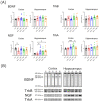Effect of Extract-Added Water Derived from Deep-Sea Water with Different Hardness on Cognitive Function, Motor Ability and Serum Indexes of Obese Mice
- PMID: 35565761
- PMCID: PMC9101427
- DOI: 10.3390/nu14091794
Effect of Extract-Added Water Derived from Deep-Sea Water with Different Hardness on Cognitive Function, Motor Ability and Serum Indexes of Obese Mice
Abstract
Deep-sea water (DSW) contains multiple minerals and is widely used as drinking water, for cosmetic purposes, and as seasoning. In this study, several types of extract-added water with different levels of hardness (200, 300, 500) were prepared from DSW collected off the coast of Muroto City, Kochi Prefecture. We administrated it to obese mice for two months and tested it for several effects. Although there was no anti-obesity effect for any hardness level in obese mice, the cognitive functions of each DSW-extract-added water-treated group were significantly improved compared to control obese mice in the water maze test. Time-to-fall by the rota-rod test was also dramatically improved in the DSW-extract-added water-treated groups. The levels of triglycerides and blood urea nitrogen were significantly decreased in DSW-extract-added water-treated obese mice. However, these results did not depend on the hardness. Hardness levels of 200 or 300 of DSW-extract-added water had greater effects on cognitive function and serum scores compared to a level of 500. We analyzed DSW using inductively coupled plasma atomic emission spectroscopy and inductively coupled plasma mass spectrometry. High concentrations of magnesium and potassium were detected, but sodium was not detected at very high concentrations. Although the detailed mechanisms of its effects are not yet understood, chronic intake of DSW-extract-added water may have a beneficial effect on health.
Keywords: cognition; deep-sea water; different hardness; motor ability; obese mice.
Conflict of interest statement
The authors declare no conflict of interest.
Figures






References
-
- Colotti G., Ilari A., Boffi A., Morea V. Metals and metal derives in medicine. Mini-Rev. Med. Chem. 2013;13:211–221. - PubMed
-
- Biochemistry, Nutrients. [(accessed on 21 December 2021)]; Available online: https://www.ncbi.nlm.nih.gov/books/NBK554545/
MeSH terms
Substances
LinkOut - more resources
Full Text Sources

